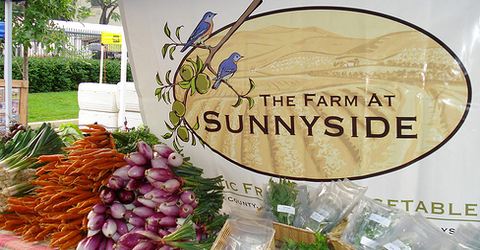Growing Organic Food and Biodiversity at Sunnyside Farm
By: Amos S. Eno
Posted on:03/01/2011 Updated:03/02/2011Nick Lapham’s Long-term Approach to Agriculture, Restoration and Life in Rappahannock County, Virginia
“Everything is more complicated than it’s painted.” A truth of being a farmer, and a larger truth about life. Those words belong to Nick Lapham, a conservationist turned farmer, who has learned their meaning in the deepest possible way.

Since 2006, Nick and his family have owned Sunnyside Farm in Rappahannock County, Virginia – a 420-acre property just 70 miles west of Washington, DC. Nick is proud of his farm, which sells certified organic fruits and vegetables, but he’s humble about his work as a farmer. “I knew virtually nothing about agriculture when we started,” he says. “And I remain heavily dependent on our incredible team of people to make the place work.”
Getting Their Hands Dirty
“We bought Sunnyside for a number of reasons,” Nick explains. “I have a background in environmental policy, particularly wildlife conservation. The farm borders Shenandoah National Park and has lots of biodiversity: bears, bobcats, rattlesnakes, salamanders, an abundance of birds. To be so close to DC and have that degree of wildness is pretty amazing.
“I was also interested because of my professional background. I’d spent a good deal of my life advocating the marriage of economic development and environmental protection. The farm gave me an opportunity to actually do it: try to run a viable business consistent with conservation principles.
“It was a proj ect of my whole family. My father was on the board of American Farmland Trust where he was active in the effort to establish some of the first local farmers’ markets in the region – an effort that eventually split off as Freshfarm Markets. My mother ran an organization concerned with community sustainability, and my wife, Gardiner, works in public health.
ect of my whole family. My father was on the board of American Farmland Trust where he was active in the effort to establish some of the first local farmers’ markets in the region – an effort that eventually split off as Freshfarm Markets. My mother ran an organization concerned with community sustainability, and my wife, Gardiner, works in public health.
“The opportunity to own Sunnyside grabbed us because it blended so many of these interests and experiences. It was a chance to get our hands dirty.”
Then came one of those complicated and unexpected twists on life’s journey. “My father died suddenly six weeks after we bought the farm,” Nick relates.
Tony Lapham’s death was a great personal loss to many people, including me. He was one of my earliest and most loyal donors and friends while at the National Fish and Wildlife Foundation, and he is how I got to know Nick. 
“The first job I ever had was working for you, Amos, as an intern at NFWF when it was still in the Interior Department,” Nick reminds me. Nick later worked on the Yellowstone wolf reintroduction project and then returned to Washington where he served as an environmental advisor in the State Department and White House during the Clinton Administration before holding senior positions at the UN Foundation, Conservation International and World Wildlife Fund.
Growing Food and Biodiversity
“Our goal at Sunnyside is to grow food and grow biodiversity in a mutually reinforcing and sustainable way that improves the land, provides for the people who work there and demonstrates synergy between agriculture and conservation. One of our first decisions was to put the farm under easement. We worked with the Virginia Outdoors Foundation and concluded the easement in 2009.
“Like Colorado, Virginia has a very progressive and rewarding incentive. Beyond the federal tax deduction, it allows a state tax credit for the partial easement value. We were able to sell our tax credits and then plow that money back into the property.”
Making Science Count
At Sunnyside Farm, good science is integral to the twin goals of economic and ecosystem sustainability. ”We’ve hired a biologist from SUNY’s Environmental Studies and Forestry Program and tasked him with putting scientific muscle behind our efforts. He’s working on a comprehensive GIS database and developing baseline inventories for key species groups – initially, plants, birds, insects and amphibians. Ultimately we aim to increase diversity and abundance while enhancing ecosystem services, such as pollination, pest control, soil stability and water quality.”
Please check back tomorrow to learn how Nick Lapham is learning to take the long view on more of life’s complications by practicing the art of native grass restoration.
 Sign In
Sign In
 Sign In
Sign In
